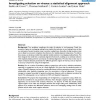Free Online Productivity Tools
i2Speak
i2Symbol
i2OCR
iTex2Img
iWeb2Print
iWeb2Shot
i2Type
iPdf2Split
iPdf2Merge
i2Bopomofo
i2Arabic
i2Style
i2Image
i2PDF
iLatex2Rtf
Sci2ools
100
click to vote
BMCBI
2008
2008
Investigating selection on viruses: a statistical alignment approach
Background: Two problems complicate the study of selection in viral genomes: Firstly, the presence of genes in overlapping reading frames implies that selection in one reading frame can bias our estimates of neutral mutation rates in another reading frame. Secondly, the high mutation rates we are likely to encounter complicate the inference of a reliable alignment of genomes. To address these issues, we develop a model that explicitly models selection in overlapping reading frames. We then integrate this model into a statistical alignment framework, enabling us to estimate selection while explicitly dealing with the uncertainty of individual alignments. We show that in this way we obtain un-biased selection parameters for different genomic regions of interest, and can improve in accuracy compared to using a fixed alignment. Results: We run a series of simulation studies to gauge how well we do in selection estimation, especially in comparison to the use of a fixed alignment. We show t...
Related Content
| Added | 08 Dec 2010 |
| Updated | 08 Dec 2010 |
| Type | Journal |
| Year | 2008 |
| Where | BMCBI |
| Authors | Saskia de Groot, Thomas Mailund, Gerton Lunter, Jotun Hein |
Comments (0)

